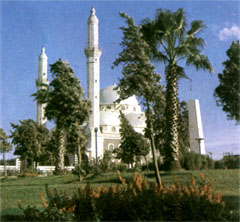“Silk route” after Doura Europos and Palmyra. It still retains this position of importance today, as the oil pipelines pass through the city. Unfortunately, many buildings and citadels in Homs were destroyed by ancient earthquakes.
There remains only one citadel in the south of the city with its Damascus and Palmyra gates. This historical city produced many impressive personalities.

Khaled Ibn Al-Walid Mosque
Among the most significant historic constructions remaining in Homs is the mosque of Khaled ibn al-Walid, the great commander of the Muslim Arab armies. Two very tall white-stone minarets lend lightness to the imposing structure. The slender colonnade in black and white stone in horizontal rows is representative of traditional Syrian architecture.
Many churches still stand in Homs from the days of early Christianity
in Syria. One of these churches is said to possess the girdle of the
Blessed Virgin. The church of
St. Elian is unique for its collection of
fine frescoes discovered in 1970. These bear inscriptions in Greek and
Arabic, and date back to the end of the 12th century.
The Nuri mosque also
dates back to the 12th century, distinguished for its beautiful entrance.
In the Homs museum, there are many archaeological artifacts dating
back to the ancient Syrian, Greek, Roman, Byzantine and Arab eras.
The Qattina lake is 15km from Homs, it is rich in fish, and has the
first rainwater dam used in agriculture which dates back to the 2nd
millennium B.C. Close to this lake is the archaeological hill called Tel
al-Nabi Mand (Qadesh), where a historic battle took place between the
Hittites and the Egyptians in the thirteenth century B.C.
(ALEPPO - DAMASCUS - LATAKIA - PALMYRA - HAMA - ZABADANI)
(BOSRA - BANYAS - TARTUS - ARWAD)
EGYPT - LEBANON - JORDAN